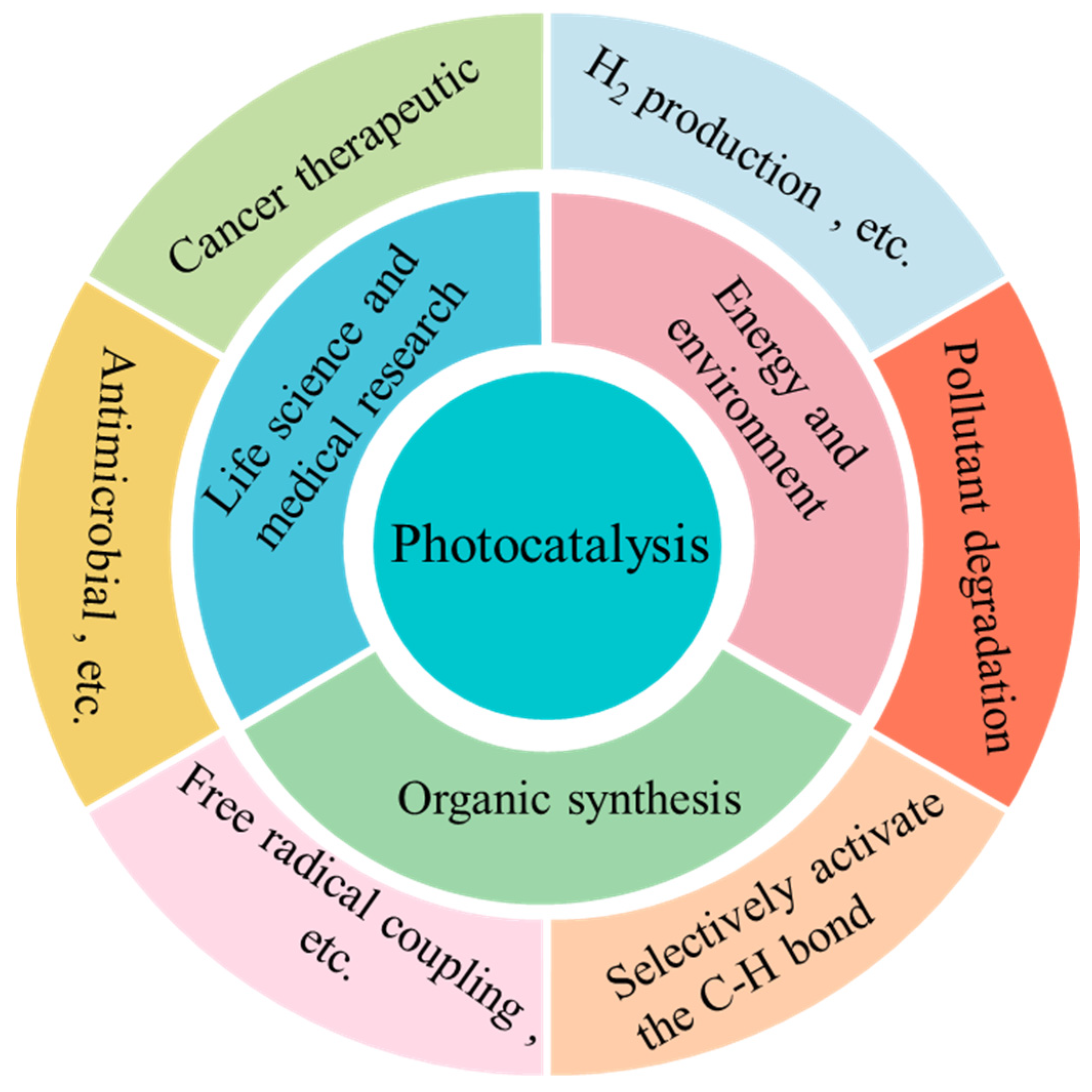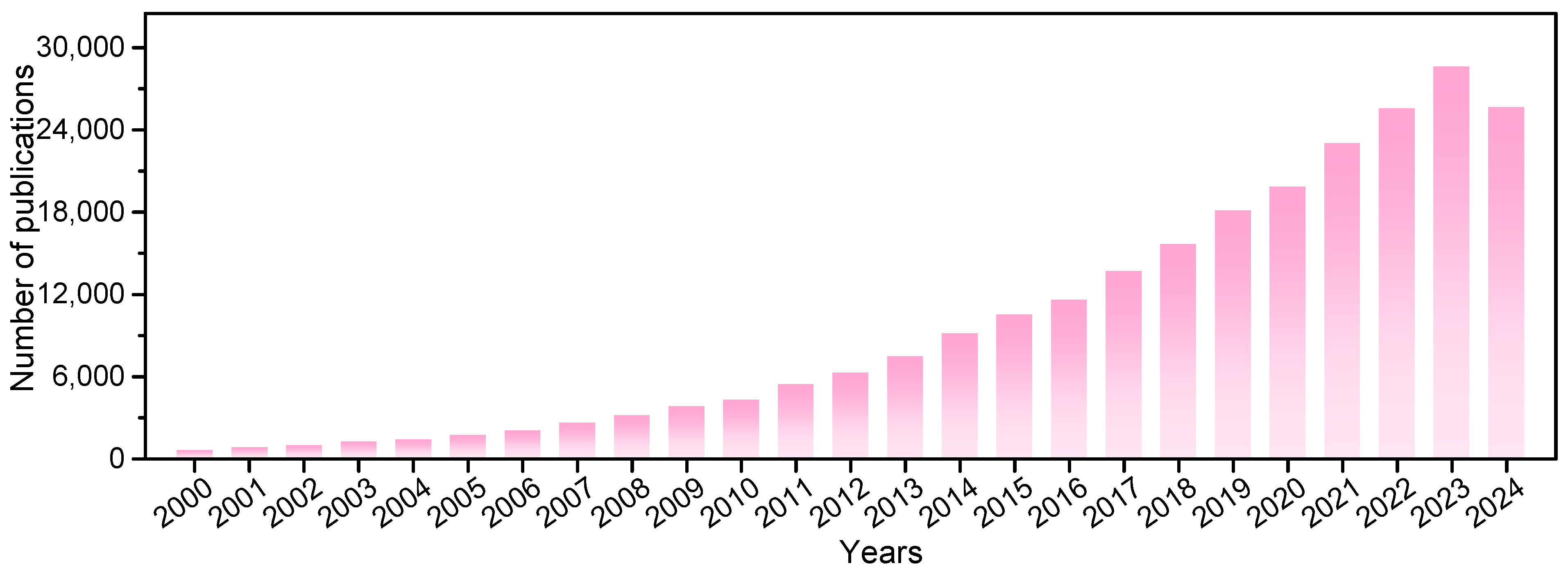Photocatalytic Materials and Photocatalytic Reactions
1. Introduction
2. An Overview of the Published Articles
3. Conclusions
Acknowledgments
Conflicts of Interest
List of Contributions
- Shan, C.; Su, Z.; Liu, Z.; Xu, R.; Wen, J.; Hu, G.; Tang, T.; Fang, Z.; Jiang, L.; Li, M. One-Step Synthesis of Ag2O/Fe3O4 Magnetic Photocatalyst for Efficient Organic Pollutant Removal via Wide-Spectral-Response Photocatalysis–Fenton Coupling. Molecules 2023, 28, 4155.
- Wu, K.; Shang, Y.; Li, H.; Wu, P.; Li, S.; Ye, H.; Jian, F.; Zhu, J.; Yang, D.; Li, B.; et al. Synthesis and Hydrogen Production Performance of MoP/a-TiO2/Co-ZnIn2S4 Flower-like Composite Photocatalysts. Molecules 2023, 28, 4350.
- Long, B.; He, H.; Yu, Y.; Cai, W.; Gu, Q.; Yang, J.; Meng, S. Bifunctional hot water vapor template-mediated synthesis of nanostructured polymeric carbon nitride for efficient hydrogen evolution. Molecules 2023, 28, 4862.
- Ding, R.; Li, L.; Yu, Y.T.; Zhang, B.; Wang, P.L. Photoredox-Catalyzed Synthesis of 3-Sulfonylated Pyrrolin-2-ones via a Regioselective Tandem Sulfonylation Cyclization of 1, 5-Dienes. Molecules 2023, 28, 5473.
- Du, Z.; Gong, K.; Yu, Z.; Yang, Y.; Wang, P.; Zheng, X.; Wang, Z.; Zhang, S.; Chen, S.; Meng, S. Photoredox Coupling of CO2 Reduction with Benzyl Alcohol Oxidation over Ternary Metal Chalcogenides (ZnmIn2S3+m, m = 1–5) with Regulable Products Selectivity. Molecules 2023, 28, 6553.
- Shi, H.; Wang, H.; Zhang, E.; Qu, X.; Li, J.; Zhao, S.; Gao, S.; Chen, Z. Boosted photocatalytic performance for antibiotics removal with Ag/PW12/TiO2 composite: degradation pathways and toxicity assessment. Molecules 2023, 28, 6831.
- Dan, Y.; Xu, J.; Jian, J.; Meng, L.; Deng, P.; Yan, J.; Yuan, Z.; Zhang, Y.; Zhou, H. In Situ Decoration of Bi2S3 Nanosheets on Zinc Oxide/Cellulose Acetate Composite Films for Photodegradation of Dyes under Visible Light Irradiation. Molecules 2023, 28, 6882.
- Irfan, M.; Tahir, N.; Zahid, M.; Noreen, S.; Yaseen, M.; Shahbaz, M.; Mustafa, G.; Shakoor, R.A.; Shahid, I. The Fabrication of Halogen-Doped FeWO4 Heterostructure Anchored over Graphene Oxide Nanosheets for the Sunlight-Driven Photocatalytic Degradation of Methylene Blue Dye. Molecules 2023, 28, 7022.
- Ma, L.; Jiang, W.; Lin, C.; Xu, L.; Zhu, T.; Ai, X. CdS Deposited In Situ on g-C3N4 via a Modified Chemical Bath Deposition Method to Improve Photocatalytic Hydrogen Production. Molecules 2023, 28, 7846.
- Zhang, M.; Wu, X.; Liu, X.; Li, H.; Wang, Y.; Wang, D. Constructing In2S3/CdS/N-rGO Hybrid Nanosheets via One-Pot Pyrolysis for Boosting and Stabilizing Visible Light-Driven Hydrogen Evolution. Molecules 2023, 28, 7878.
- Wang, X.; Liu, S.; Lin, S.; Qi, K.; Yan, Y.; Ma, Y. Visible Light Motivated the Photocatalytic Degradation of P-Nitrophenol by Ca2+-Doped AgInS2. Molecules 2024, 29, 361.
- Wu, Y.; Wang, Z.; Yan, Y.; Wei, Y.; Wang, J.; Shen, Y.; Yang, K.; Weng, B.; Lu, K. Rational Photodeposition of Cobalt Phosphate on Flower-like ZnIn2S4 for Efficient Photocatalytic Hydrogen Evolution. Molecules 2024, 29, 465.
- Tian, C.; Yu, H.; Zhai, R.; Zhang, J.; Gao, C.; Qi, K.; Zhang, Y.; Ma, Q.; Guo, M. Visible Light Photoactivity of g-C3N4/MoS2 Nanocomposites for Water Remediation of Hexavalent Chromium. Molecules 2024, 29, 637.
- Sacco, N.; Iguini, A.; Gamba, I.; Marchesini, F.A.; García, G. Pd: In-Doped TiO2 as a Bifunctional Catalyst for the Photoelectrochemical Oxidation of Paracetamol and Simultaneous Green Hydrogen Production. Molecules 2024, 29, 1073.
- Wang, J.; Fu, S.; Hou, P.; Liu, J.; Li, C.; Zhang, H.; Wang, G. Construction of TiO2/CuPc Heterojunctions for the Efficient Photocatalytic Reduction of CO2 with Water. Molecules 2024, 29, 1899.
- Chu, S.; Gao, Q. Unveiling the Low-Lying Spin States of [Fe3S4] Clusters via the Extended Broken-Symmetry Method. Molecules 2024, 29, 2152.
- He, X.; Wu, Y.; Luo, J.; Dai, X.; Song, J.; Tang, Y. First-Principles Study on Janus-Structured Sc2CX2/Sc2CY2 (X, Y= F, Cl, Br) Heterostructures for Solar Energy Conversion. Molecules 2024, 29, 2898.
- Lasso-Escobar, A.V.; Castrillon, E.D.C.; Acosta, J.; Navarro, S.; Correa-Penagos, E.; Rojas, J.; Ávila-Torres, Y.P. Modulation of Electronic Availability in g-C3N4 Using Nickel (II), Manganese (II), and Copper (II) to Enhance the Disinfection and Photocatalytic Properties. Molecules 2024, 29, 3775.
- Chen, J.; Yang, M.; Zhang, H.; Chen, Y.; Ji, Y.; Yu, R.; Liu, Z. Boosting the Activation of Molecular Oxygen and the Degradation of Rhodamine B in Polar-Functional-Group-Modified g-C3N4. Molecules 2024, 29, 3836.
- Gatou, M.A.; Bovali, N.; Lagopati, N.; Pavlatou, E.A. MgO Nanoparticles as a Promising Photocatalyst towards Rhodamine B and Rhodamine 6G Degradation. Molecules 2024, 29, 4299.
- Pełech, I.; Staciwa, P.; Sibera, D.; Sobczuk, K.S.; Majewska, W.; Kusiak-Nejman, E.; Morawski, A.T.; Wang, K.; Narkiewicz, U. The Influence of Heat Treatment on the Photoactivity of Amine-Modified Titanium Dioxide in the Reduction of Carbon Dioxide. Molecules 2024, 29, 4348.
- Dai, M.Y.; Zhao, X.C.; Lei, B.C.; Huang, Y.N.; Zhang, L.L.; Guo, H.; Wang, H.G. First Principle Study on the Z-Type Characteristic Modulation of GaN/g-C3N4 Heterojunction. Molecules 2024, 29, 5355.
- Abshari, F.; Paulsen, M.; Veziroglu, S.; Vahl, A.; Gerken, M. Mimicking Axon Growth and Pruning by Photocatalytic Growth and Chemical Dissolution of Gold on TiO2 Patterns. Molecules 2024, 30, 99.
References
- Ciamician, G. The photochemistry of the future. Science 1912, 36, 385. [Google Scholar] [CrossRef] [PubMed]
- Fujishima, A.; Honda, K. Electrochemical photolysis of water at a semiconductor electrode. Nature 1972, 238, 37–38. [Google Scholar] [CrossRef]
- Lei, J.; Zhou, N.; Sang, S.; Meng, S.; Low, J.; Li, Y. Unraveling the roles of atomically-dispersed Au in boosting photocatalytic CO2 reduction and aryl alcohol oxidation. Chin. J. Catal. 2024, 65, 163–173. [Google Scholar] [CrossRef]
- Che, Y.; Weng, B.; Li, K.; He, Z.; Chen, S.; Meng, S. Chemically bonded nonmetallic LSPR S-scheme hollow heterostructure for boosting photocatalytic performance. Appl. Catal. B Environ. Energy 2025, 361, 124656. [Google Scholar] [CrossRef]
- Candish, L.; Collins, K.D.; Cook, G.C.; Douglas, J.J.; Gómez-Suárez, A.; Jolit, A.; Keess, S. Photocatalysis in the life science industry. Chem. Rev. 2021, 122, 2907–2980. [Google Scholar] [CrossRef] [PubMed]
- Kumar, P.; Singh, G.; Guan, X.; Lee, J.; Bahadur, R.; Ramadass, K.; Kumar, P.; Kibria, M.G.; Vidyasagar, D.; Yi, J.; et al. Multifunctional carbon nitride nanoarchitectures for catalysis. Chem. Soc. Rev. 2023, 52, 7602–7664. [Google Scholar] [CrossRef] [PubMed]
- Dhakshinamoorthy, A.; Li, Z.; Yang, S.; Garcia, H. Metal–organic framework heterojunctions for photocatalysis. Chem. Soc. Rev. 2024, 53, 3002–3035. [Google Scholar] [CrossRef] [PubMed]
- Li, X.; Mitchell, S.; Fang, Y.; Li, J.; Perez-Ramirez, J.; Lu, J. Advances in heterogeneous single-cluster catalysis. Nat. Rev. Chem. 2023, 7, 754–767. [Google Scholar] [CrossRef]
- Ham, R.; Nielsen, C.J.; Pullen, S.; Reek, J.N. Supramolecular coordination cages for artificial photosynthesis and synthetic photocatalysis. Chem. Rev. 2023, 123, 5225–5261. [Google Scholar] [CrossRef] [PubMed]
- Sayed, M.; Yu, J.; Liu, G.; Jaroniec, M. Non-noble plasmonic metal-based photocatalysts. Chem. Rev. 2022, 122, 10484–10537. [Google Scholar] [CrossRef]
- Zhang, H.; Gao, Y.; Meng, S.; Wang, Z.; Wang, P.; Wang, Z.; Chen, S.; Weng, B.; Zheng, Y.-M. Metal sulfide S-scheme homojunction for photocatalytic selective phenylcarbinol oxidation. Adv. Sci. 2024, 11, 2400099. [Google Scholar] [CrossRef] [PubMed]
- Su, B.; Kong, Y.; Wang, S.; Zuo, S.; Lin, W.; Fang, Y.; Hou, Y.; Zhang, G.; Zhang, H.; Wang, X. Hydroxyl-Bonded Ru on Metallic TiN Surface Catalyzing CO2 Reduction with H2O by Infrared Light. J. Am. Chem. Soc. 2023, 145, 27415–27423. [Google Scholar] [CrossRef] [PubMed]
- Meng, S.; Chen, C.; Gu, X.; Wu, H.; Meng, Q.; Zhang, J.; Chen, S.; Fu, X.; Liu, D.; Lei, W. Effcient photocatalytic H2 evolution, CO2 reduction and N2 fxation coupled with organic synthesis by cocatalyst and vacancies engineering. Appl. Catal. B Environ. 2021, 285, 119789. [Google Scholar] [CrossRef]
- Nishiyama, H.; Yamada, T.; Nakabayashi, M.; Maehara, Y.; Yamaguchi, M.; Kuromiya, Y.; Nagatsuma, Y.; Tokudome, H.; Akiyama, S.; Watanabe, T.; et al. Photocatalytic solar hydrogen production from water on a 100-m2 scale. Nature 2021, 598, 304–307. [Google Scholar] [CrossRef] [PubMed]
- Yang, J.; Li, L.; Xiao, C.; Xie, Y. Dual-Plasmon Resonance Coupling Promoting Directional Photosynthesis of Nitrate from Air. Angew. Chem. Int. Ed. 2023, 62, e202311911. [Google Scholar] [CrossRef] [PubMed]
- Liu, D.; Xu, H.; Shen, J.; Wang, X.; Qu, C.; Lin, H.; Long, J.; Wang, Y.; Dai, W.; Fang, Y.; et al. Decoupling H2 and O2 Release in Particulate Photocatalytic Overall Water Splitting Using a Reversible O2 Binder. Angew. Chem. Int. Ed. 2024. [Google Scholar] [CrossRef]



Disclaimer/Publisher’s Note: The statements, opinions and data contained in all publications are solely those of the individual author(s) and contributor(s) and not of MDPI and/or the editor(s). MDPI and/or the editor(s) disclaim responsibility for any injury to people or property resulting from any ideas, methods, instructions or products referred to in the content. |
© 2025 by the author. Licensee MDPI, Basel, Switzerland. This article is an open access article distributed under the terms and conditions of the Creative Commons Attribution (CC BY) license (https://creativecommons.org/licenses/by/4.0/).
Share and Cite
Meng, S. Photocatalytic Materials and Photocatalytic Reactions. Molecules 2025, 30, 269. https://doi.org/10.3390/molecules30020269
Meng S. Photocatalytic Materials and Photocatalytic Reactions. Molecules. 2025; 30(2):269. https://doi.org/10.3390/molecules30020269
Chicago/Turabian StyleMeng, Sugang. 2025. "Photocatalytic Materials and Photocatalytic Reactions" Molecules 30, no. 2: 269. https://doi.org/10.3390/molecules30020269
APA StyleMeng, S. (2025). Photocatalytic Materials and Photocatalytic Reactions. Molecules, 30(2), 269. https://doi.org/10.3390/molecules30020269




